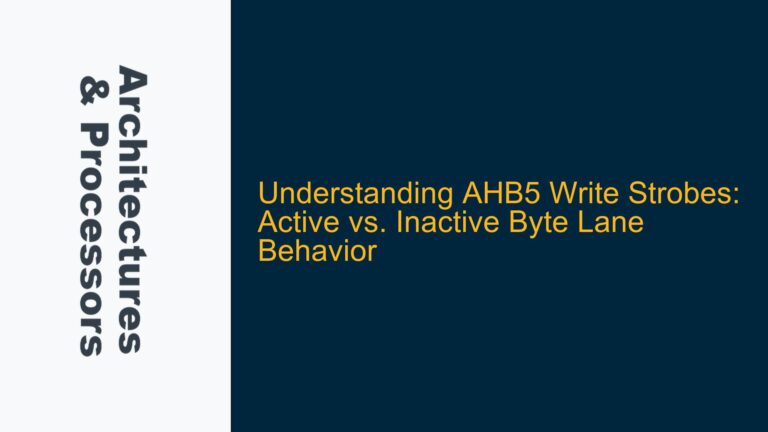AHB Slave HREADY Signal Behavior During Multi-Slave Transactions
The AHB (Advanced High-performance Bus) protocol is a critical component of ARM’s AMBA (Advanced Microcontroller Bus Architecture) family, widely used in SoC designs for efficient communication between masters and slaves. One of the key signals in the AHB protocol is HREADY, which plays a dual role as both an input and an output signal for AHB slaves. This dual functionality is essential for managing data transfers in multi-slave systems, ensuring proper synchronization between address and data phases, and maintaining bus efficiency.
In a multi-slave AHB system, the HREADY signal serves as a handshake mechanism between the master and the slaves. The HREADY output from a slave (often referred to as HREADYOUT) indicates whether the slave is ready to complete the current data transfer. This signal is multiplexed and fed back to the master and all slaves as the global HREADY input. The HREADY input to a slave informs it about the completion status of the current data phase, allowing it to determine when to start its own data transfer.
Consider a scenario with one master (M0) and three slaves (S0, S1, S2). When M0 initiates a transaction with S0, S0 drives its HREADYOUT signal to indicate whether it is ready to complete the data transfer. This HREADYOUT signal is fed back to all slaves, including S2, as the HREADY input. If M0 then requests a transaction with S2, S2 uses the HREADY input to determine when the final data phase transfer to S0 is completing. Once HREADY goes high, S2 samples the address phase signals (HTRANS, HADDR, HWRITE, etc.) and begins its own data transfer.
The HREADY input is crucial because it allows slaves to synchronize their operations with the current bus activity. Without this input, a slave would not know when the previous transfer is completing and when it should start its own transfer. This synchronization is particularly important in systems with multiple slaves, where overlapping transactions can occur.
HREADY Input Role in Synchronizing Address and Data Phases
The HREADY input to an AHB slave serves two primary purposes: it indicates the completion of the current data phase transfer and signals the start of a new address phase transfer. This dual role is essential for maintaining the correct sequence of operations in the AHB protocol, which separates address and data phases.
When a master initiates a transfer, it drives the address phase signals (HTRANS, HADDR, HWRITE, etc.) to specify the type and destination of the transfer. The slave selected by the address phase (indicated by the HSEL signal) then enters the data phase, where it drives the HREADYOUT signal to indicate its readiness to complete the transfer. The HREADYOUT signal from the active slave is multiplexed and fed back to all slaves as the HREADY input.
The HREADY input informs each slave about the status of the current data phase. When HREADY is low, the current data phase is still ongoing, and the slave must wait. When HREADY goes high, it indicates that the current data phase is completing, and the next address phase can begin. At this point, the slave checks its HSEL signal to determine if it is the next selected slave. If HSEL is high, the slave samples the address phase signals and prepares to enter its own data phase.
This mechanism ensures that slaves do not start their data phases prematurely, which could lead to bus contention or data corruption. It also allows the master to pipeline transactions, initiating a new address phase while the previous data phase is still completing, thereby improving bus efficiency.
In the example of M0 and three slaves (S0, S1, S2), when M0 switches from S0 to S2, S2 uses the HREADY input to determine when the final data phase transfer to S0 is completing. Once HREADY goes high, S2 samples the address phase signals and begins its own data transfer. This synchronization is critical for maintaining the integrity of the bus protocol and ensuring correct operation in multi-slave systems.
Implementing HREADY Signal Management in AHB Slave Designs
Proper implementation of the HREADY signal in AHB slave designs requires careful consideration of both the input and output roles of the signal. The HREADYOUT signal must be generated based on the slave’s internal state and its ability to complete the current data transfer. The HREADY input must be used to synchronize the slave’s operations with the bus activity.
To implement the HREADYOUT signal, the slave must monitor its internal state and determine whether it can complete the current data transfer. If the slave is ready, it drives HREADYOUT high; otherwise, it drives HREADYOUT low. This signal is then multiplexed with the HREADYOUT signals from other slaves and fed back to the master and all slaves as the global HREADY input.
The HREADY input must be used to synchronize the slave’s operations with the bus activity. When HREADY is low, the slave must wait for the current data phase to complete. When HREADY goes high, the slave checks its HSEL signal to determine if it is the next selected slave. If HSEL is high, the slave samples the address phase signals and prepares to enter its own data phase.
In the example of M0 and three slaves (S0, S1, S2), when M0 switches from S0 to S2, S2 uses the HREADY input to determine when the final data phase transfer to S0 is completing. Once HREADY goes high, S2 samples the address phase signals and begins its own data transfer. This synchronization is critical for maintaining the integrity of the bus protocol and ensuring correct operation in multi-slave systems.
To ensure proper operation, the slave’s internal logic must be designed to handle the timing requirements of the HREADY signal. This includes ensuring that the HREADYOUT signal is driven with the correct timing relative to the bus clock and that the HREADY input is sampled at the appropriate time to synchronize with the bus activity.
In summary, the HREADY signal plays a critical role in the AHB protocol, serving as both an input and an output signal for AHB slaves. Proper implementation of this signal is essential for managing data transfers in multi-slave systems, ensuring proper synchronization between address and data phases, and maintaining bus efficiency. By understanding the behavior and role of the HREADY signal, designers can implement robust and efficient AHB slave designs that meet the requirements of complex SoC architectures.






